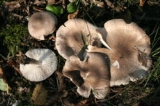
Tricholoma argyraceum
Encyclopedia
Tricholoma argyraceum is a grey-capped edible mushroom
of the large genus Tricholoma. It has been confused with the similar-looking Tricholoma scalpturatum.
described this species as Agaricus argyraceus in 1779, before his countryman Claude Casimir Gillet
gave it its current name in 1874. The generic
name derives from the Greek
trichos/τριχος 'hair' and loma/λωμα 'hem', 'fringe' or 'border'. It lies within the section terrea within the subgenus Tricholoma within the genus Tricholoma.
is conical initially and flattening to a convex shape, with a prominent boss. Measuring 1.5 to 6 cm (0.6–2.4 in) in diameter, it is covered with greyish scales, paler than other grey-capped tricholomas, and the crowded gills are white or pale grey and emarginate or adnate in cross section. They sometimes stain yellowish when bruised. The thin flesh is cream or white and has a farinaceous (floury) and somewhat rancid taste and smell. The whitish stipe is 2–5 cm (0.8-1 in) high and 0.3–0.8 cm (0.1–0.3 in) wide and has no ring and a tapering base.
The poisonous T. pardinum
is similar in appearance but with coarser scales on its cap. T.scalpturatum has a darker cap without a boss.
.
Mushroom
A mushroom is the fleshy, spore-bearing fruiting body of a fungus, typically produced above ground on soil or on its food source. The standard for the name "mushroom" is the cultivated white button mushroom, Agaricus bisporus; hence the word "mushroom" is most often applied to those fungi that...
of the large genus Tricholoma. It has been confused with the similar-looking Tricholoma scalpturatum.
Taxonomy
French mycologist Pierre BulliardJean Baptiste François Pierre Bulliard
Jean Baptiste François Pierre Bulliard was a French physician and botanist....
described this species as Agaricus argyraceus in 1779, before his countryman Claude Casimir Gillet
Claude Casimir Gillet
Claude Casimir Gillet, born 19 May 1806, died 1896, was a French botanist and mycologist. He initially trained as a medical doctor and veterinarian.-Publications:* Claude-Casimir Gillet, * Claude-Casimir Gillet, , 230 pp...
gave it its current name in 1874. The generic
Genus
In biology, a genus is a low-level taxonomic rank used in the biological classification of living and fossil organisms, which is an example of definition by genus and differentia...
name derives from the Greek
Ancient Greek
Ancient Greek is the stage of the Greek language in the periods spanning the times c. 9th–6th centuries BC, , c. 5th–4th centuries BC , and the c. 3rd century BC – 6th century AD of ancient Greece and the ancient world; being predated in the 2nd millennium BC by Mycenaean Greek...
trichos/τριχος 'hair' and loma/λωμα 'hem', 'fringe' or 'border'. It lies within the section terrea within the subgenus Tricholoma within the genus Tricholoma.
Description
The capPileus (mycology)
The pileus is the technical name for the cap, or cap-like part, of a basidiocarp or ascocarp that supports a spore-bearing surface, the hymenium. The hymenium may consist of lamellae, tubes, or teeth, on the underside of the pileus...
is conical initially and flattening to a convex shape, with a prominent boss. Measuring 1.5 to 6 cm (0.6–2.4 in) in diameter, it is covered with greyish scales, paler than other grey-capped tricholomas, and the crowded gills are white or pale grey and emarginate or adnate in cross section. They sometimes stain yellowish when bruised. The thin flesh is cream or white and has a farinaceous (floury) and somewhat rancid taste and smell. The whitish stipe is 2–5 cm (0.8-1 in) high and 0.3–0.8 cm (0.1–0.3 in) wide and has no ring and a tapering base.
The poisonous T. pardinum
Tricholoma pardinum
Tricholoma pardinum, commonly known as spotted tricholoma, tiger tricholoma, tigertop or dirty trich, is a gilled mushroom widely distributed across North America and Europe, as well as parts of Asia. It is generally found in beech woodland in summer and autumn...
is similar in appearance but with coarser scales on its cap. T.scalpturatum has a darker cap without a boss.
Distribution and habitat
Tricholoma argyraceum occurs across Europe but is uncommon overall. The fruit bodies appear from June to December (occasionally earlier in Spring). The species has an ectomycorrhizal association with a number of genera – birch (Betula), Carpinus, oak (Quercus) and TiliaTilia
Tilia is a genus of about 30 species of trees native throughout most of the temperate Northern Hemisphere. The greatest species diversity is found in Asia, and the genus also occurs in Europe and eastern North America, but not western North America...
.

